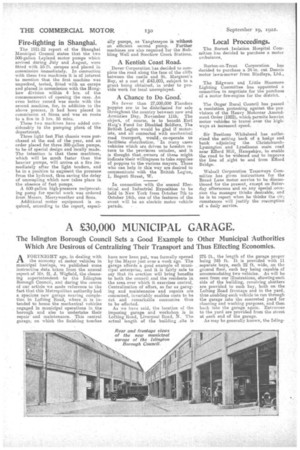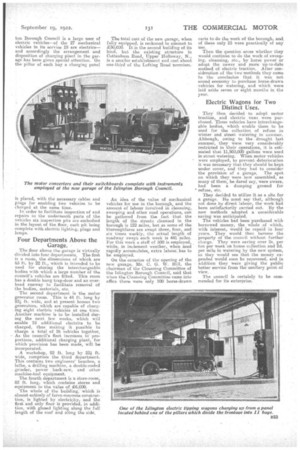A £30,000 MUNICIPAL GARAGE,
Page 8

Page 9

If you've noticed an error in this article please click here to report it so we can fix it.
The Islington Borough Council Sets a Good Example to Other Municipal 'Authorities Which Are Desirous of Centralizing Their Transport and Thus Effecting Economies.
AFORTNIGHT ago, in dealing with the economy of motor vehicles in municipal haulage, we published some instructive data taken from the annual report of Mr. H. J. Wigfield, the cleansing superintendent to the Islington Borough Council, and during the course of our article we made reference to the fact that this Metropolitan authority had a spacious new garage nearing completion in Lofting Road, where it is intended to house the mechanical vehicles engaged in municipal operations in the borough and also to undertake their repair ' and maintenance. This central garage, on which the finishing touches
have now been put, was formally opened by the Mayor just over a week ago. The garage affords a good example of municipal enterprise, arid it is fairly safe to say that its erection will bring benefits to both the council and the residents in the area over which it exercises control. Centralization of effort, so far as geraging and maintenance and repairs are concerned, invariably enables costs to be Cut and remarkable economies thus to be effected.
As we have said, the location of the imposing garage and workshop is in Lofting Road, Liverpool Bead, N. The actual length of the building _site is
276 ft., the length of the garage proper being 245 ft. It is provided with 11 separate bays, each 22 ft. wide, on the ground floor, each hay being capable of accommodating two vehicles. As will be seen from our illustrations showing each side of the building, revolving shutters are provided to each bay, both on the Lofting Road frontage and in the yard, thus enabling each vehicle to run through the garage into the concreted yard for cleaning and washing purposes' and then back into the garage again. Entrances to the yard are provided from the street at each end of the garage.
As may be generally known, the Isling ton Borough Council is a large user of electric vehicles—of the 27 mechanical vehicles in its service 19 are electricsand accordingly the arrangement and disposition of charging plant in the garage has been given special attention. On the pillar of each bay a charging panel is placed, with the necessary Cables and plugs for enabling two vehicles to be charged at the same time.
In order to facilitate inspection of and repairs to the underneath parts of the vehicles six inspection pits are embodied in the layout of the floor, each pit being complete with electric lighting, plugs and lamps.
Four Departments Above the Garage. •
The floor above the garage is virtually divided into four departments. The first is a room, the dimensions of which are 63 ft. by 22 ft., which is intended to be used for storing the interchangeable bcidies with which a large number of the council's vehicles are fitted. This room has a double hung trap-door and an overhead runway to facilitate removal of the bodies, materials, etc.
The second department is the motor generator room. This is 44 ft. long by 24 ft. wide, and at present houses two generators, which are capable of charging eight electric vehicles at one time. Another machine is to be installed during the next few weeks, which will enable 18 additional electrics to be charged, thus making it possible to charge a total of 26 vehicles together. As the council's fleet increases in proportions, additional charging plant, for which'provision has been made, will be incorporated.
A workshop, 82 ft. long by 24 ft. wide, comprises the third department. This contains two engineers' benches, a lathe, a drilling maehine, a double-ended grinder, power . hack-saw, and ether machine-tool equipment.
The fourth department is a Store-room, 82 ft. long, which contains stores and eitipment to the value of• £6,000. The whole of the building,' which is almcist entirelY of ferro-concrete construction, is lighted by 'electricity, and the first and only floor is provided, in addition, With glazed lighting along the fall length of the roof and alOng the side. The total. cost of the new garage, when fully equipped, is reckoned to amount to £30,000. It is the second building of its kind, but the existing structure in Cottenbam Road, Upper Holloway, N., is a smaller establishment and cost about one-third of the Lofting Road premises.• An idea of the value of mechanical vehicles for use in the borough, and the amount of labour involved in cleansing, sweeping and other road operations, can be gathered from the fact that the length of the streets cleansed in the borough is 122 miles, but as some of the thoroughfares are swept three, four, and six times weekly, the actual length of roadway swept each week is 441. miles. For this work a staff of 500 is employed, while, in inelement weather, when mud rapidly accumulates, extra labour, has to be employed.
On the occasion of the opening of the new garage, Mr. C. G. W. Hill, the -chairman of the Cleansing Committee of the Islington Borough Council, said that when the Cleansing Committee came into office there were only 100 horse-drawn carts to do the work of the borough, and of these only 25 were practically of any Use.
Then the question arose whether they would continue to do the work of seeping, cleansing, stc., by horse power or adapt the newer and more up-to-date method of electric traction. After consideration of the two methods they .carno to the conclusion that it was not sound economy to -purchase horse-drawn vehicles for watering, and which were laid aside seven or eight months in the year.
Electric Wagons for Two Distinct Uses.
They then decided to adopt motor traction, and electric vans were purchased. These vehicles have interchangeable bodies, which enable them to be used for the collection of refuse in winter and .street watering in summer. Although, owing to the drought last summer, they were very considerably restricted in their operations, it is estimated that 11,500,000 gallons were used in street watering. When motor vehicles were employed, to prevent deterioration it wed necessary that they should be kept under cover, and they bad ta consider the provision of a garage, The spot on Which they were now assembled, as many of them, he dared say, were aware, had been a dumping ground for refuse, etc.
They decided to utilize it as a site for a garage. He must say that, although not done by direct labour, the work had been satisfactorily carried out. By the new methods adopted a considerable saving was anticipated. The vehicles had been purchased with borrowed money, the whole of which, with interest, would be repaid -in four years. They would then become the property of the council without further charge. They were saving over 2s, per ton per week on house collection and 2d. per mile in watering by the new system, so they would see that the money expended would soon be recovered, and in addition they were giving the public better service from the' sanitary point of view.
The council is certainly to be commended for its enterprise.






























